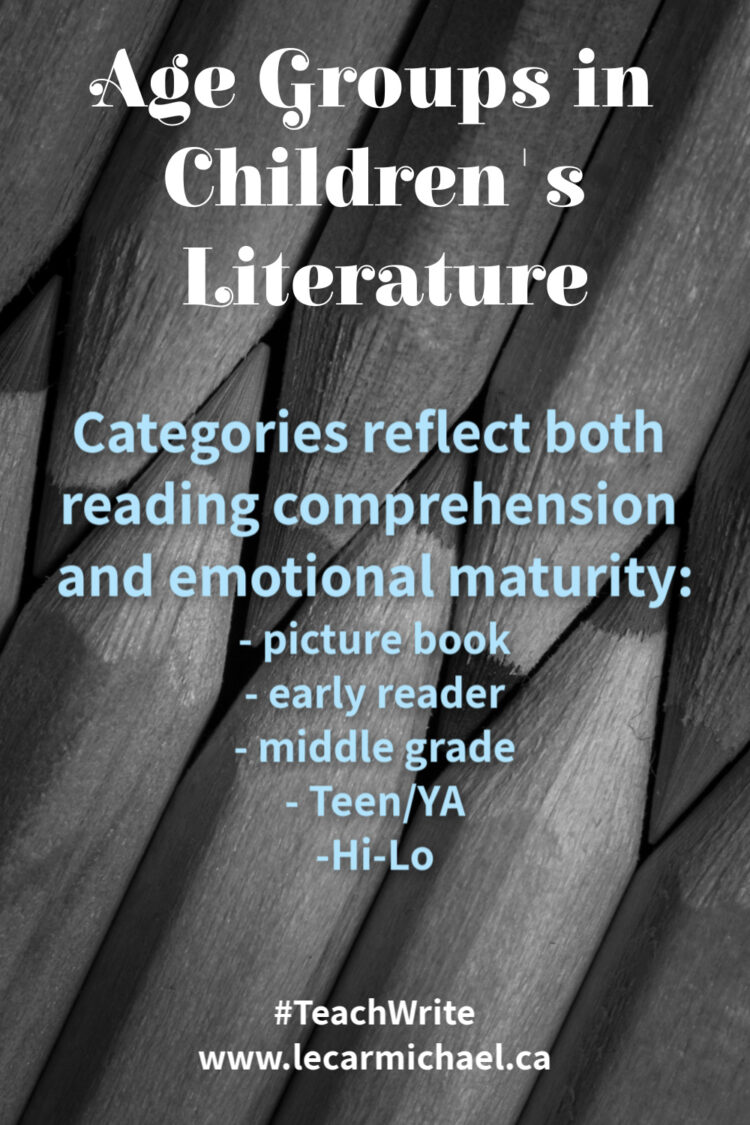 Welcome to Teach Write! This column draws on my 20 years’ experience teaching writing to kids, university students, and adult learners. It includes ideas and exercises that teachers can use in the classroom, and creative writers can use to level up their process.
Welcome to Teach Write! This column draws on my 20 years’ experience teaching writing to kids, university students, and adult learners. It includes ideas and exercises that teachers can use in the classroom, and creative writers can use to level up their process.
This will be our final column on audience (at least for now). So buckle up for a crash course on age levels in children’s literature!
First, a caveat: the categories I’m presenting here are not absolute. Different people use different words to describe them, and set the cutoffs in slightly different places. As children’s writers, we must also be aware that every kid learns to read at his or her own pace, so there’s going to be a lot of variation in text complexity within categories, too. Publishers and parents are always looking to strike a balance between a child’s reading comprehension, and the ideas or themes they are emotionally ready for (see my previous Teach Write post about dual audiences in kid lit).
End of PSA, let’s dig in!
Pre-Readers – Ages 0-6ish
This category (obviously) is designed for kids who aren’t yet reading on their own. We’re talking board books and picture books, and magazines like Babybug. The word count is typically very short, but the vocabulary can be relatively high, because at this age, adults are reading to kids.
Early Readers – Ages 6-9
Now we are talking about kids that are learning to read independently. Kids in this age group have a wide range of confidence levels, so may be reaching for anything from a picture book, to a levelled reader, to an early chapter book.* At the chapter book phase, the text is obviously longer than for picture books. However, sentences tend to be shorter and simpler in structure, and vocabulary is typically lower than for books targeting pre-readers. That’s because beginning readers are still building their visual word-recognition skills, and they can become intimidated if the text looks too hard.
Middle Grade – Ages 8-12
Kids in this age group have developed more confidence as readers, so they can handle more complex texts. That will involve higher vocabulary and greater complexity in syntax (hello, compound sentences!). It could also involve novels that have subplots in addition to the main plot, or a larger cast of characters. Themes (in both fiction and non-fiction) are also “older” at this level, reflecting the audience’s greater emotional maturity and curiosity about the wider world.
Teen or Young Adult (YA) – Ages 12+
Most bookstores have a single section for YA, but most publishers (and booksellers) will tell you that there are actually two categories here: tween, which is typically 10-14, and “upper YA”, which is typically 15+. Teens in both groups are proficient readers, so this split is all about content. How much do your characters swear and how physical are their romantic relationships? If there’s a lot of realistic violence (as opposed to the kind typical of fantasy novels), or drugs/alcohol, you’re probably writing for older teens.
Teen Hi-Lo, or Reluctant Readers
This is a special category, for teens** who are emotionally ready for mature themes, but are not yet proficient readers. These books have high-concept, engaging plot lines, with a snappy pace and lower text complexity. They give teens stories that are interesting and relevant to their lives, while being quick reads for those who are still building their reading skills.
Bonus Writing Exercise: How to write about practically anything for practically any audience.***
Your challenge (should you choose to accept it) is to brainstorm ways to adapt a single topic for every type of audience listed here. A topic to get you started: the perennial favourite, DINOSAURS! And feel free to share your results in the comments, for those of us who learn by example!
Hey, did you know I teach writing workshops? It’s true – I work with adult writers, teachers, and students of all ages. Contact me to learn more.
*Kids that have reached the “chapter book” stage are (justifiably!) VERY proud of themselves!
**When I worked at Chapters, we also had adult literacy organizations looking for books like these. Ask for them if you’re working with adult or second-language learners.
***Yes, of course there are exceptions. That’s why I said “practically.” 😉